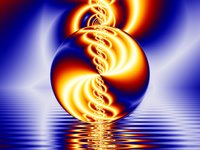
Fractal Art: the Hidden Beauty in Numbers
 My passion for making fractal art has deepened, to the extent that friends and family are beginning to worry about me. Virtually every evening, around 8:00 p.m. — after spending all day on the computer — I fire up a fractal program, and don't seem to be able to extricate myself til midnight, or later. (At least it's weaned me off the TV!)
My passion for making fractal art has deepened, to the extent that friends and family are beginning to worry about me. Virtually every evening, around 8:00 p.m. — after spending all day on the computer — I fire up a fractal program, and don't seem to be able to extricate myself til midnight, or later. (At least it's weaned me off the TV!) I started out with Ultra Fractal, which I have blogged about here before. More recently, I began wading into the murky waters of a freeware program called Apophysis. The two programs are very different, as are the images they generate. You can often tell a UF image by the bold colours and almost psychedelic feel of the work. Images generated in Apophysis tend to be softer and more delicate, somehow — generally a little more subtle. The image at the top of this post was done with Ultra Fractal. The one to the left of this paragraph is an Apo fractal. Both programs are capable of creating mind-boggling works of art that explore unseen dimensions and seem to probe infinity itself.
I started out with Ultra Fractal, which I have blogged about here before. More recently, I began wading into the murky waters of a freeware program called Apophysis. The two programs are very different, as are the images they generate. You can often tell a UF image by the bold colours and almost psychedelic feel of the work. Images generated in Apophysis tend to be softer and more delicate, somehow — generally a little more subtle. The image at the top of this post was done with Ultra Fractal. The one to the left of this paragraph is an Apo fractal. Both programs are capable of creating mind-boggling works of art that explore unseen dimensions and seem to probe infinity itself. I have recently been experimenting with Ultra Fractal's transformations — special effects you can apply to a fractal. One of these allows you to create a kaleidoscopic effect, as in the example at the right of this paragraph. Other transformations include the mirror ball and shimmering lake effects you see in the first image in this post.
I have recently been experimenting with Ultra Fractal's transformations — special effects you can apply to a fractal. One of these allows you to create a kaleidoscopic effect, as in the example at the right of this paragraph. Other transformations include the mirror ball and shimmering lake effects you see in the first image in this post.
Another recent discovery was a technique for outputting fractals as transparent PNGs. Removing the default black background opens up all kinds of creative possibilities. You can place the fractal on a background image, for example, as David Annal does at his site, ApophyStash. I use this method so I can create multiple versions of a fractal, with different background colours. To do this, just output your Apo fractal as a PNG. Then open it in PhotoShop. Add a new layer and drag it down below the fractal layer. Then choose a colour and fill the new layer with the paint bucket or gradient tool. The fractal will appear to float over the background.
Creating fractal art is definitely a trial and error process, and incredibly time-consuming. I don't want to use the word "addictive," but I'm beginning to feel like I'm in the throes of a very strong compulsion.
Where to Download Software
There are many fractal programs. Here are a few of the most popular:- Ultra Fractal ($59 and worth every penny)
- Apophysis (freeware)
- Tierazon (freeware)
- Fractal Explorer (freeware)



























